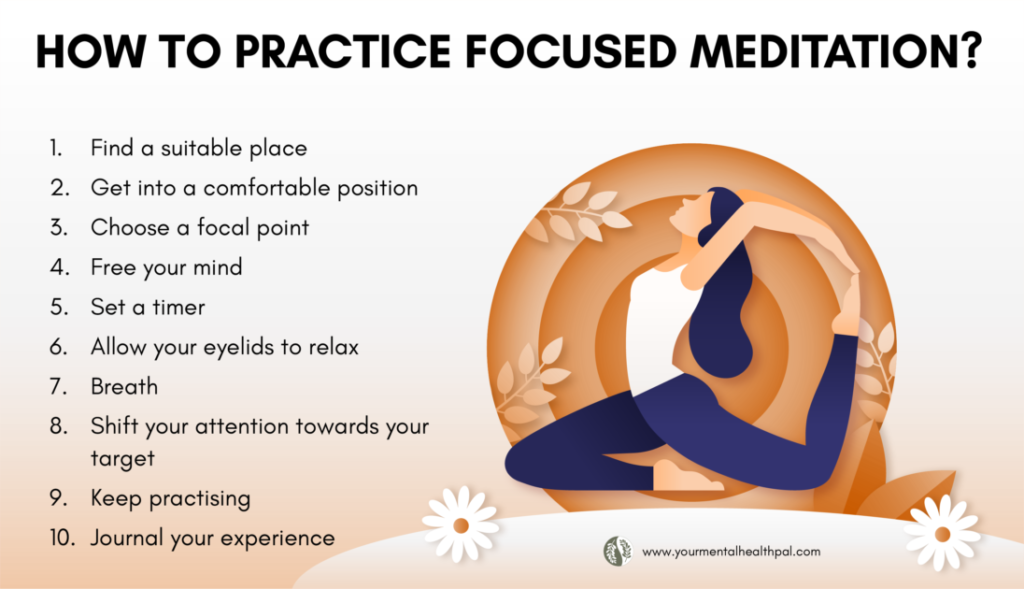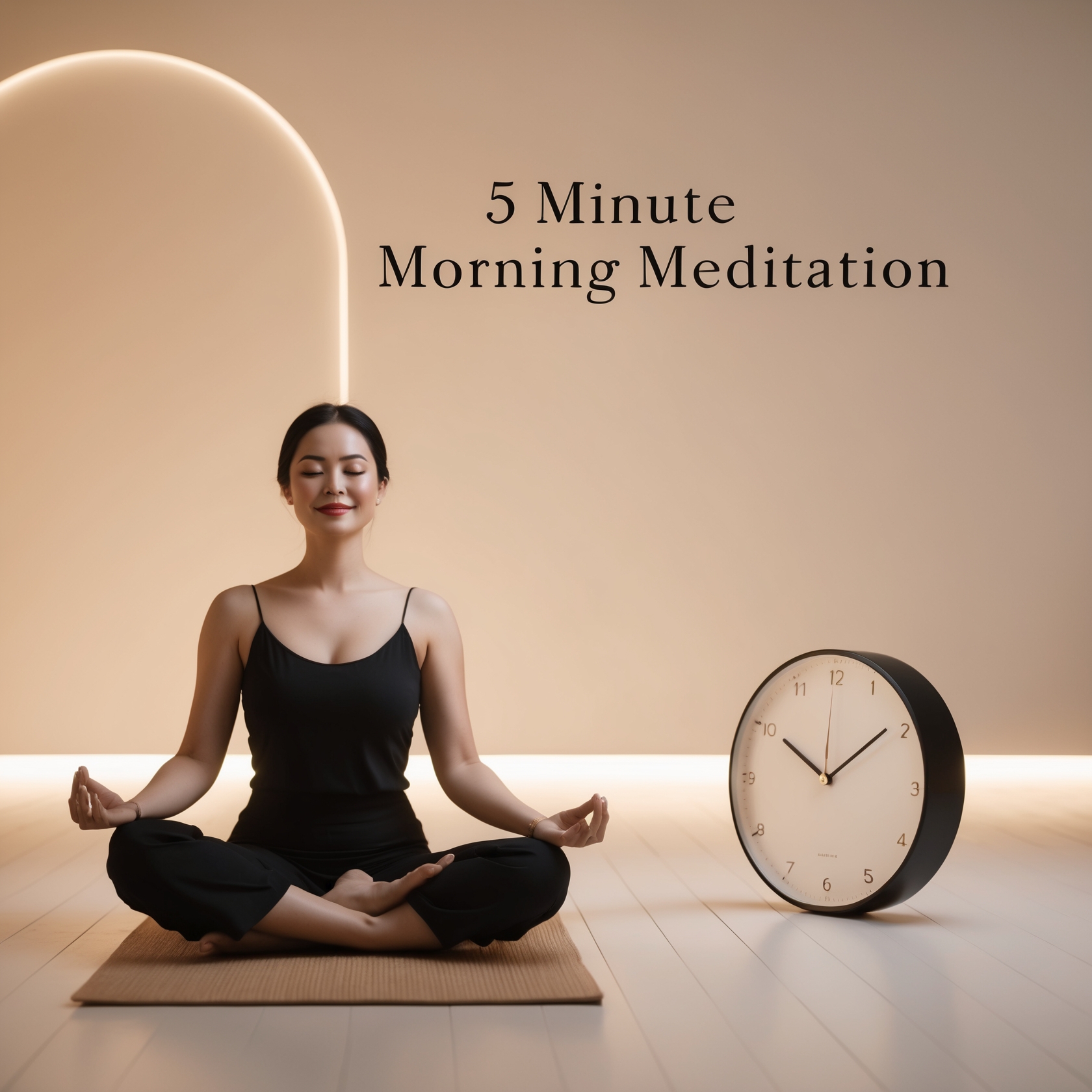We throw around the term ‘meditation for focus’ a bit too casually these days, but it is very relevant to our modern day world filled with distractions. Think about it; we often check our phones while responding to emails, mindlessly scroll through social media during breakfast, and most bafflingly, completely lose track of what we were doing upon entering a room. Sounds relatable, doesn’t it?
Rest assured, if you often feel pressure in your head with racing thoughts and irritation caused by short attention span, know that this is the new norm. Forcing singular focus too aggressively often backfires, one of the worst precedents you can set for yourself. Instead, what you need to do is train your mind to calm down and relax, and this is where the right technique of meditation comes into play.
In this article, we will outline an uncomplicated, easy-to-follow strategy that can be implemented immediately. This approach is perfect for complete novices, as well as those fidgety individuals who cannot sit still for prolonged periods of time. And the best part? It works with your brain’s natural rhythm — not against it.
Why It’s So Hard to Focus Today
Let’s be honest — the world we live in isn’t designed for focus. It’s designed for stimulation. You’re bombarded with notifications, auto play videos, breaking news, endless tabs, background noise… and somehow expected to concentrate like a monk.
This constant stream of micro-interruptions does more than just distract you. It conditions your brain to expect novelty every few seconds. The more we engage with rapid information shifts, the harder it becomes to stay grounded on one task. That’s not a lack of willpower — it’s a trained response.
Add to that the mental clutter: unfinished thoughts, stress about deadlines, overthinking past conversations, or rehearsing what you’ll say next. All of it pulls your attention in ten directions before you even start working.
This is where meditation for focus becomes more than a wellness trend. It’s a retraining tool. It slows the loop, resets your cognitive rhythm, and allows your brain to settle into one thing at a time. Unlike most productivity hacks, it doesn’t ask for more effort — it asks for less. Less noise, less input, and less internal chaos.
And that’s exactly why it works.
Try This Meditation for Focus (No, It’s Not Just Breathing)
If you’ve ever sat down to meditate and ended up feeling more distracted than before, you’re not alone. Most advice starts with “just focus on your breath” — which is great in theory. But when your mind feels like a traffic jam of thoughts, silence can actually make the chaos louder.
That’s why this method works differently.
This isn’t about achieving stillness from the start. It’s about giving your mind something gentle to hold onto — something that naturally brings it back when it wanders. That process of “returning” is where real focus is built. And the best part? You don’t have to sit like a monk or meditate for an hour. Just a few minutes a day can shift your mental rhythm.
Let’s break it down.
What Makes This Method Different
When people say “just meditate,” they often mean sitting silently and focusing on the breath. But if your mind is already racing, silence can feel unbearable. The pressure to “empty your thoughts” only makes it worse.
This approach is different — it doesn’t expect stillness upfront. Instead, it gives your mind something gentle to hold onto. It’s based on the idea of anchoring — where you combine breath, a simple word, and your senses to help your attention land somewhere specific. This is what makes it an ideal meditation for focus, even for those who feel too fidgety or overstimulated to sit still.
The goal isn’t to block out thoughts. The goal is to notice, gently return, and train that return like a mental muscle — because that’s where the focus builds.
How to Practice This Meditation (Step-by-Step)
You can do this in under 10 minutes — no special setup required.
- Sit in a relaxed but upright posture. A chair works just fine.
- Close your eyes and take 3 slow breaths. No need to force it.
- Bring your awareness to sound. Notice 3–4 sounds around you — without labeling or judging them.
- Now, choose an “anchor word.” Something neutral and short, like “Now,” “Here,” or “Calm.”
- As you inhale, say the word silently. As you exhale, repeat it again.
- Your mind will wander. That’s fine. Each time, just come back to your anchor.
- Continue for 5–7 minutes. Or more, if it feels good.
Why It Works — Even for Busy, Overthinking Minds
This isn’t about achieving a mystical state or visualizing light flowing through your chakras. It’s about training your attention to return to something stable. That small act — the return — is what rewires your focus, not the length of time you sit.
- The anchor word gives your mind a job — so it doesn’t panic in stillness.
- Noticing sound brings you into your environment gently, without force.
- The breath slows your nervous system down — naturally enhancing concentration.
Do this consistently — even for a few minutes a day — and you’ll notice your focus doesn’t just improve during meditation. It shows up in meetings, while writing, during conversations, and especially when you’re about to mentally check out.
When to Meditate for Focus And How Often?
You don’t need an elaborate morning ritual or a Himalayan retreat to benefit from meditation for focus. What matters most isn’t how long you meditate — it’s when and how often you do it. Just like training a muscle, consistency builds results over time, even if the reps are small.
Timing your meditation right can also amplify its impact. Your brain is more receptive to focus-building practices at certain moments in the day — moments that you might already overlook.
Best Times to Practice
Here are a few windows where meditation works especially well:
- Before starting your workday: Sets a grounded tone and clears mental noise
- Midday reset (especially after screen-heavy tasks): Helps you return to clarity without relying on caffeine
- Before important tasks: Calms nerves, centers attention
- Evening wind-down: Useful if you feel mentally “full” and need to decompress
You don’t need to pick all of them. Choose one that fits your routine and feels sustainable.
How Often Should You Meditate?
The short answer: daily, even if it’s just for 3–5 minutes. Think of it like brushing your teeth — short, regular upkeep is better than occasional deep cleans.
Try starting with:
- 5 minutes a day for the first week
- Increase to 10–15 minutes once it feels more natural
- If you skip a day, don’t quit — just start again tomorrow
There’s no perfect schedule. The real goal is building a habit that teaches your mind to come back — again and again — without judgment.
Tools That Make It Easier to Meditate for Focus
Let’s be honest — sitting quietly with your thoughts isn’t always easy. Some days your brain feels like a browser with too many tabs open, and others, you just can’t sit still. The good news? You don’t have to rely on willpower alone.
There are tools that can gently guide you into a focused state — no pressure, no fluff. These aren’t crutches; they’re just supportive layers that make the process feel less intimidating and more inviting, especially when you’re starting out.
- Guided Meditations: Apps like Insight Timer, Headspace, or YouTube channels dedicated to meditation for focus offer short, structured sessions. Having someone walk you through the process can reduce the mental resistance of “doing it wrong.”
- Background Sounds and Frequencies: If silence feels too sharp, try ambient soundtracks or focus-enhancing frequencies like 432 Hz or binaural beats. These create a soothing audio environment that makes it easier for your mind to settle.
- Visual Anchors or Objects: If you’re a visual person, try meditating with a candle flame, a mandala, or even a smooth crystal. These tactile or visual cues help ground your awareness in the present moment. (Tip: Fluorite and Tiger’s Eye are often used to support mental clarity.)
- Timer Apps with Gentle Bells: Avoid harsh alarms. Apps like Meditation Timer & Log or Insight Timer let you set soft chimes so you can begin and end your practice peacefully without checking the clock.
- Journaling Right After: A quick 2-minute journaling session after meditating helps reinforce focus. Write down one thought you kept returning to or how you felt before vs. after. This helps track progress and keeps the practice intentional.
You don’t need all these tools. Just pick one or two that feel intuitive and make the experience easier, not more complicated. The real tool is your attention — everything else just helps you bring it home.
Long-Term Benefits of Meditation for Focus
If you stick with it — even imperfectly — meditation starts showing up in your life in ways you didn’t expect. Yes, you’ll be able to concentrate better during tasks, but the real transformation goes deeper.
Meditation for focus isn’t just about getting more done. It’s about changing how your mind responds to distraction, pressure, and overstimulation — not by resisting it, but by returning to presence faster each time.
Here’s what you may begin to notice over time:
- Better Focus Without Forcing It: Tasks that used to feel overwhelming become smoother. You’ll catch yourself staying with one thing longer — not because you’re trying harder, but because your mind is less reactive.
- Mental Clarity and Emotional Stability: When your attention isn’t being yanked in ten directions, your emotions feel less volatile. You become more aware of your thoughts before they spiral — and that’s powerful.
- Lower Dependence on Stimulation: As your inner world becomes more grounded, the urge to constantly scroll, check, or switch tabs fades. You begin to enjoy stillness, not run from it.
- Better Decision-Making: Focused attention means clearer judgment. When your mind isn’t cluttered, it’s easier to see what matters — whether it’s during work, conversations, or personal choices.
- Increased Self-Trust: You’ll notice a subtle shift: you start trusting your focus. Even when you drift off, you know how to return. That confidence grows with each session.
These changes don’t arrive all at once. But with regular practice, they build — quietly and consistently — until focus is no longer something you chase. It becomes the baseline you return to.
Final Thoughts on Meditation for Focus
In a world that profits from your distraction, choosing to focus is a quiet act of power. And meditation for focus isn’t about perfection, empty minds, or forcing silence — it’s about building the ability to return. To notice when your mind drifts, and bring it gently back, again and again.
This isn’t something you master in a day. But even a few minutes of consistent practice can retrain how your brain handles chaos, pressure, and inner noise. That return — the moment you catch yourself and come back — is where the rewiring happens.
You don’t need to change your life to try this. You just need to pause, breathe, and be willing to start.
So the next time you feel scattered, try this. Not to get it right — but to show up for your own attention.














